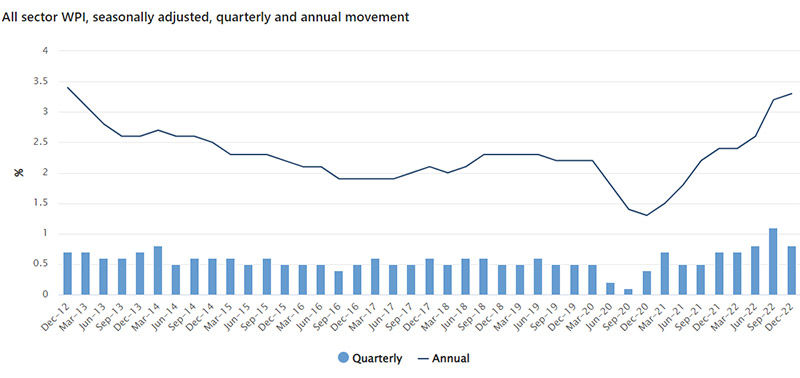Modest wage growth offers hope of interest rate reprieve
New wages data shows Australian pay packets are swelling at a slower pace than the RBA and others expected, offering a sliver of hope that further interest rate hikes may be delayed or reduced.
Lower than expected wage growth in Australia for the latest quarter has offered a glimmer of hope to borrowers that further interest rate rises may be delayed.
After a record run of nine consecutive monthly rate hikes by the Reserve Bank of Australia, financially stretched mortgagees were bracing for even more hits to the monthly household budget in the form of higher loan repayments.
Inflation at an uncomfortable 7.8 per cent have forced the hand of RBA Governor Philip Lowe and his Board but the wages figure released Wednesday (22 February) by the Australian Bureau of Statistics may offer some incentive to the RBA to take a breather.
The seasonally adjusted Wage Price Index (WPI) rose 0.8 per cent in the December quarter 2022, and 3.3 per cent annually.
Economists and other commentators had been expecting wage growth to hit 3.5 per cent and the RBA would have been eagerly awaiting the announcement. The lower than expected figure may help convince Mr Lowe and his team to hold off on further hits to workers whose incomes are being rapidly eroded by inflation and higher interest rates.

Source: Australian Bureau of Statistics - Annual Wage Growth - December Quarter 2022.
Michelle Marquardt, ABS Head of Prices Statistics, said the increase in hourly wage rates for the December 2022 quarter was lower than the increase for the September quarter (0.8 per cent compared to 1.1 per cent).
“It was, however, higher than any December quarter increase across the last decade.
“This follows on from the September and June 2022 quarters that were also higher than their comparable quarters back to 2012.
“In combination these quarterly increases have resulted in the highest annual growth in hourly wages since December quarter 2012.”
While the lower than expected wage growth will register on the RBA radar, inflation remains the their focus and upwards pressure on interest rates remains significant.
The central bank expects wages growth to accelerate to 4.2 per cent by the end of the year, which would be among the fastest rates of increase since records began in 1997.
Sean Langcake, Head of Macroeconomic Forecasting, BIS Oxford Economics, said the breakout in wages growth was not as bad as the RBA had feared.
"Nevertheless, the labour market continues to track in a very tight position.
“The WPI is a narrow measure of wage growth and this data will not completely allay the RBA’s concerns over a wage-price spiral.
“We expect to see rate hikes at the next three meetings.”
Private sector wage growth over the quarter (0.8 per cent) was slightly higher than in the public sector (0.7 per cent). However, consistent with the September quarter 2022, annually, wage growth in the private sector (3.6 per cent) has remained significantly higher than the public sector (2.5 per cent).
Private sector wage growth over the quarter (0.8 per cent) was slightly higher than in the public sector (0.7 per cent). However, consistent with the September quarter 2022, annually, wage growth in the private sector (3.6 per cent) has remained significantly higher than the public sector (2.5 per cent).
Quarterly wage growth across industries was highest in the Accommodation and food services industry (1.7 per cent) and lowest in the Administrative and support services industry (0.3 per cent).
Annual wage growth was highest in the Wholesale trade industry (4.2 per cent), its highest growth since December quarter 2012. The Education and training industry recorded the lowest annual growth in wages (2.4 per cent).
David Bassanese, chief economist, Betashares told media the latest wages data may alleviate the temptation for the RBA to deliver a super-sized 0.5 percentage point rate increase in March, which it has considered at recent board meetings.
“The good news for workers is that wage growth is picking up, while the good news for the RBA is that the acceleration in wage growth remains reasonably modest and is not yet at a pace inconsistent with its long-run 2 to 3 per cent inflation target,” Mr Bassanese said.




















